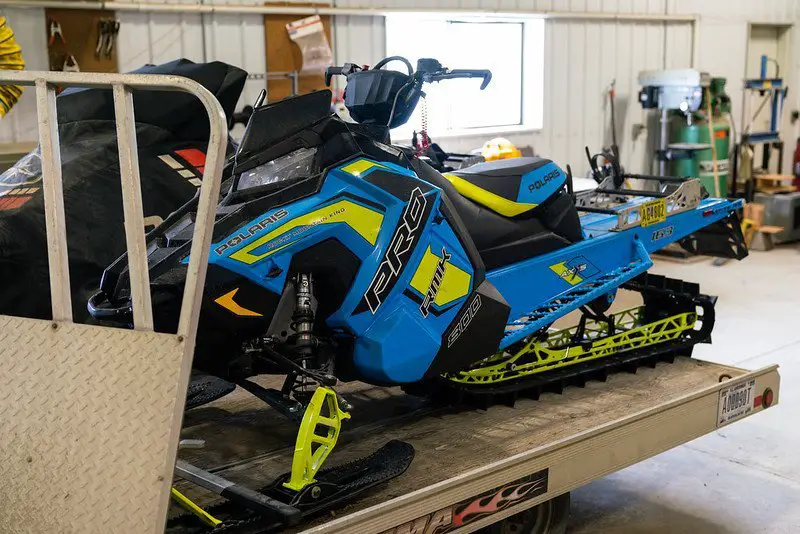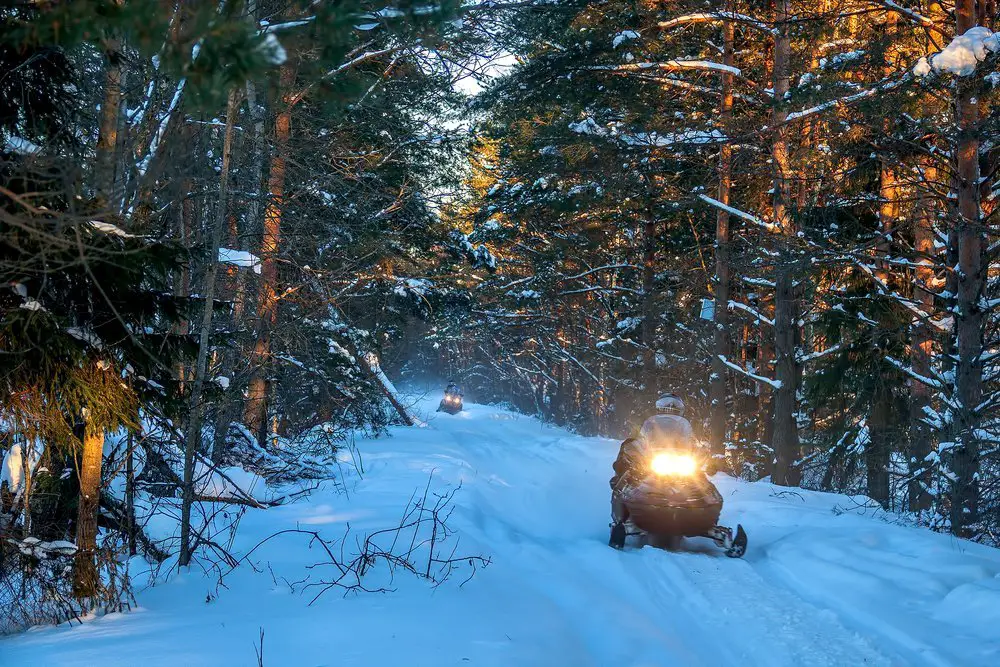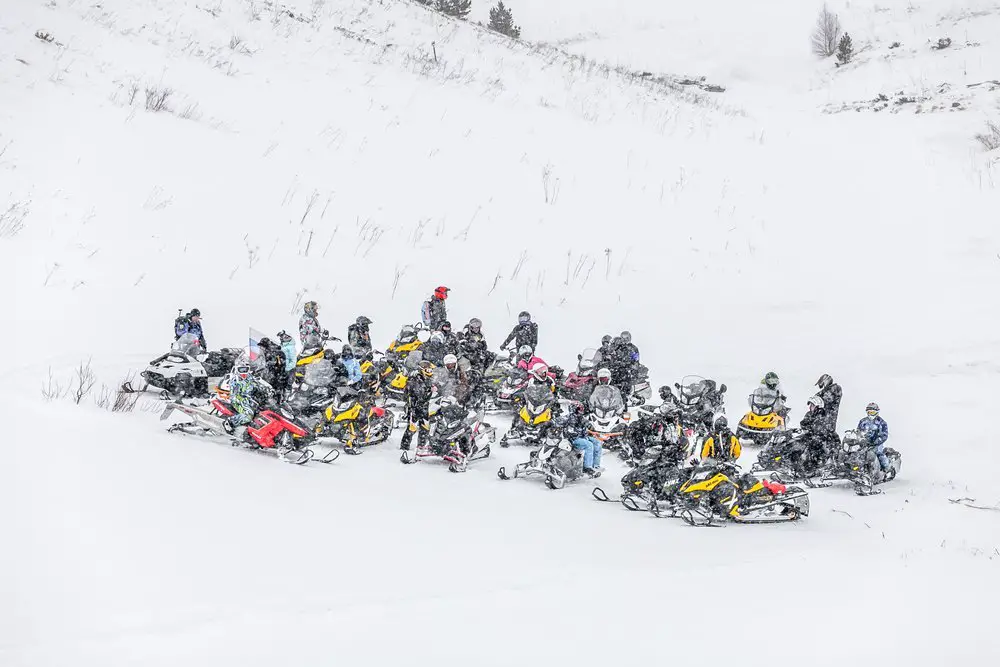Looking into getting a 2-stroke snowmobile? It’s a good choice. Many people these days prefer 2-stroke snowmobiles to 4-stroke snowmobiles because:
2-stroke engines are lighter, and they can also produce more power than a 4-stroke engine. On top of that, they are far cheaper to rebuild than their 4-stroke counterparts, this is due to the simplicity of their build.
Below, I’ve put together a post covering some important things you should know when it comes to 2-stroke snowmobiles. Feel free to check it out.
Table of Contents
Are 2 stroke snowmobiles better than 4 stroke?
The answer to this question depends entirely on your personal preferences. Ask yourself the following questions:
- Do you like light or heavy snowmobiles?
- Are you looking for more torque?
- Do you prefer reliability to power and speed?
- What kind of riding do you do? (mountain, trail riding, touring etc.)
All of these questions need to be answered for you to decide which snowmobile is best for you.
4-stroke snowmobiles offer better fuel economy, reliability and longevity than 2-stroke snowmobiles. However, 2-stroke snowmobiles are much lighter and offer you more speed, and maneuverability while also being cheaper to purchase and repair.
If you are a ditch banger that loves to playfully ride off trails and up or around mountains, a 2-stroke snowmobile is going to be the right choice for you.
If you prefer trail riding through groomed trails and other more flat and predictable surfaces or plan on using your snowmobile more so for everyday tasks, a 4-stroke snowmobile would be the right choice for you.
How long does a 2-stroke snowmobile engine last?
Before committing to purchasing a new snowmobile, it’s almost always everyone’s first instinct to wonder how many miles you can get out of it. When you opt to go with a 2-stroke over a 4-stroke, you are choosing to sacrifice a little reliability in exchange for better speed, maneuverability and lighter weight.
A 2-stroke snowmobile engine will last between 2500-5000 miles before it needs a top end refresh and between 7500-15,000 miles before it will need a complete rebuild. The style of riding you do is a major factor. Mountain riding is much harder on your engine than trail riding, and so mountain riders find themselves rebuilding their 2-strokes much sooner than trail riders.
It also really depends on the type of 2-stroke engine you have. For example, with a 600cc snowmobile you could go 5,000 miles before ever needing to look at the engine. Whereas a 800cc snowmobile will be good for 2500 miles on average before it requires attention.
Of course there will be outliers on both ends of the spectrum, a few years ago I purchased a brand new 2017 Polaris pro rmk 800 that bit the bullet after only about 700 miles. Meanwhile, my dads 02 polaris 600 went nearly 7500 miles (without proper maintenance) before it even needed to be opened up.
Your best bet to squeeze the most out of your 2-stroke snowmobile is by performing regular maintenance and even doing a top end rebuild of your engine every 3000 miles or so.
What is a snowmobile engine top end rebuild?
A top end rebuild of your snowmobile engine, often referred to as a top end refresh, is done every couple thousand miles to ensure the longevity of your engine. Performing a top end rebuild of your snowmobile engine includes checking and replacing worn pistons, piston rings, cylinders as well as the accompanying o-rings and gaskets.
The best way to tell if your snowmobile needs a new top end is by performing a compression test. If your cylinders read below 110 PSI or if the PSI of your cylinders is not relatively equal, it’s safe to say you should either perform a top end rebuild yourself, or take it in to be serviced.
A complete top end rebuild of your snowmobile engine will cost you between $500-$1000, depending on your snowmobile model. It will be cheaper if you are able to do it on your own, as you won’t be paying for labor.
To learn how to perform a top end rebuild, take a look at this video:
How much compression should a 2 stroke snowmobile have?
Proper compression is essential in a working internal combustion engine.
For optimal performance, your 2-stroke snowmobile should have equal compression between 120-150 PSI. If you notice more than a 5% different between your cylinders or if you are getting less than 110 PSI, you may need a top end rebuild.
If you just rebuilt your engine, you may still notice lower compression until the new parts get broken in.
To check your compression, you need two things, a spark plug wrench to remove your spark plugs and a compression tester, which you can easily find online.
When you are ready to perform the test:
- Run your engine until it reaches operating temperatures and ensure your throttle is held open.
- Remove your spark plugs, then shut off your fuel supply and ignition.
- Take your compression test hose and thread it into the spark plug hole.
- Attach the compression tester to the hose.
- Pull your engine over until the gauge on the compression tester stops moving.
Once the gauge stops moving, you will know your true PSI reading.
How to check crank seals on a 2 stroke snowmobile
A bad crank seal can often times cause backfiring, idling problems and even engine failure.
The best way to check your crank seals is to perform a leak down test. If you do not know how to perform a leak down test, it’s recommended you take your snowmobile to a shop where they can properly perform the test for you.
If you wish to learn how to perform a leak down test yourself, watch this video.
An easier way you can check your crank seals is by spraying ether or wd40 behind the primary clutch. If it revs up, or you notice changes in idling, that’s a sign that you do have a leak.
Can you turbocharge a 2 stroke snowmobile?
For a long time, the only way to have a turbo 2-stroke snowmobile engine was if you modified it yourself. Until recently, it was thought impossible to produce turbocharged 2-stroke snowmobiles in a factory.
This was until Ski-Doo introduced the world’s first ever 2-stroke turbo engine produced from a factory with the Rotax 850 E-TEC Turbo engine.
What gas do you put in a 2 stroke snowmobile?
The type of fuel you should be using for your snowmobile will be listed in your snowmobiles’ user manual. Generally, you should use fuel that has a minimum octane reading of 87 to avoid damaging the engine. For best performance, 91-octaine fuel is recommended by most snowmobile manufacturers.
Ethanol fuel (maximum 10%) is fine if you intend to use all the fuel up and do not let it sit in your tank for long periods of time. Ethanol absorbs water through the air and can cause all sorts of damage if it is left sitting in your snowmobile while you store it.
How to warm up a 2 stroke snowmobile
Failing to warm up your sled before riding can sometimes cause irreparable damage.
The best way to warm up your 2-stroke snowmobile is to fire it up and let it idle without revving until you are able to feel heat coming through the heat exchanger. This will indicate the engine is heated enough to where the internals have already reached normal operating temperatures.
I know what it’s like to be in a rush to hit the snow, but it’s not worth those repair costs! Take the time to properly warm up your sled.
Final thoughts
2-stroke snowmobiles dominate the current snowmobile market, and it’s clear to see why.
People like lightweight machines that go fast and are easy/cheap to repair. However, 2-stroke engines do not tend to last as long as 4-stroke’s, so it’s a good idea to perform regular maintenance to ensure the longevity of the engine.
Thanks for reading, enjoy the snow!
Check out this article if you are having trouble getting your snowmobile going after sitting for a while.
References
https://www.ski-doo.com/ca/en/ski-doo-feeling/technologies/rotax-engines.html
powersportsbusiness.com/top-stories/2020/01/15/ski-doo-unveils-new-2-stroke-turbo-snowmobile/



